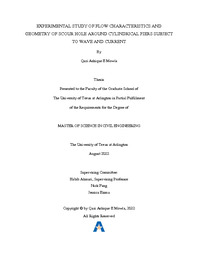
ATTENTION: The works hosted here are being migrated to a new repository that will consolidate resources, improve discoverability, and better show UTA's research impact on the global community. We will update authors as the migration progresses. Please see MavMatrix for more information.
Show simple item record
| dc.contributor.advisor | Ahmari, Habib | |
| dc.creator | Mowla, Qazi Ashique E | |
| dc.date.accessioned | 2023-06-28T20:29:21Z | |
| dc.date.available | 2023-06-28T20:29:21Z | |
| dc.date.created | 2022-08 | |
| dc.date.issued | 2022-08-15 | |
| dc.date.submitted | August 2022 | |
| dc.identifier.uri | http://hdl.handle.net/10106/31423 | |
| dc.description.abstract | This thesis concerns the unique flow structure around bridge piers under the wave and current conditions. The flow characteristics around piers may change depending on the flow conditions and geometry of the pier. These flow structures imprint themselves on the streambed as scour holes. Laboratory experiments were conducted to investigate the changes that occur in the flow pattern and in the geometric pattern of scour holes around piers in waterbodies subject to waves and currents. Physical models of two piers with different diameters (19 mm and 50 mm) were built and installed in a sediment bed. A total of 19 sets of experiments were conducted on three types of flow conditions: waves alone; current alone; and waves and current combined, in which the direction of the wave propagation was opposite the direction of the current. The effects of variables such as flow velocity, water depth, wave height, wave period, and pier size were studied to determine their influence on the geometry of scour holes. The data obtained from the laboratory experiments showed that scour holes were largest in flow with a steady current and smallest in water with only waves. The combination of waves and current produced scour depths larger than those of the waves-alone experiments but smaller than those conducted in water with only currents.
Particle image velocimetry (PIV) was utilized to visualize the flow structure around piers under various flow conditions. A horizontal plane view of the flow field was analyzed and changes in vortex characteristics were investigated. Higher flow velocity produced stronger vortices in a steady current. For the waves-alone cases, when the pier was smaller in diameter, more scour was observed. The flow structure in the combined waves and current experiments was much more complex, although the flow characteristics were dominated by the current, the flow pattern around the pier was affected by the wave characteristics as well. Velocity vectors obtained from the PIV analysis showed that the mean displacement of sediment particles was in the same direction as the current. The presence of negative velocity was also observed when the wave motion was against the current.
Finally, an attempt was made to relate the size of the vortices to the scour process. A clear-water flow regime was designed to ensure that the sediment movement that occurred during the experiments was caused by the pier in the sediment bed disturbing the flow structure. The results showed that the strength of wake vortices, the relative direction of the flow, and the distances of waves from the channel bottom influenced the scour pattern around the cylindrical pier and the downstream deposition pattern. | |
| dc.format.mimetype | application/pdf | |
| dc.language.iso | en_US | |
| dc.subject | Flow characteristics | |
| dc.subject | PIV | |
| dc.subject | Scour hole geometry | |
| dc.subject | Wave-current | |
| dc.title | Experimental Study of Flow Characteristics and Geometry of Scour Hole Around Cylindrical Piers Subject to Wave and Current | |
| dc.type | Thesis | |
| dc.date.updated | 2023-06-28T20:29:21Z | |
| thesis.degree.department | Civil Engineering | |
| thesis.degree.grantor | The University of Texas at Arlington | |
| thesis.degree.level | Masters | |
| thesis.degree.name | Master of Science in Civil Engineering | |
| dc.type.material | text | |
| dc.creator.orcid | 0000-0003-0969-0848 | |
| local.embargo.terms | 2023-08-01 | |
| local.embargo.lift | 2023-08-01 | |
Files in this item
- Name:
- MOWLA-THESIS-2022.pdf
- Size:
- 5.891Mb
- Format:
- PDF
This item appears in the following Collection(s)
Show simple item record


